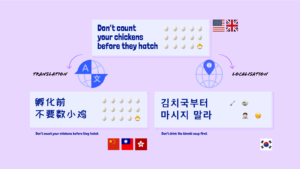An expert salesperson will tell you how difficult it is to penetrate a new market. So if you’re trying to build a global brand, how can you establish a strong market base for your brand and products? This is where localisation is key.
Localising your brand means taking time to study the audience in your target countries; what is culturally appropriate, the languages they speak, and how it applies to them. These research will greatly influence how you decide to localise your product such that it fits the local market.
If you’re from a startup or small business that does not have huge budgets for localisation consultants, this article is for you. Keep reading to find out how brand marketing works, the most common localisation services available, and how to choose the best localisation partner for your marketing needs.
Types of Localisation Services
There are many types of localisation practices, and the three most common ones are voiceovers, subtitling, and translation.
- Voice overs. This can be termed partial localisation because the graphical content remains intact during translation. However, this can be very effective as having your video content spoken in a local language is key to helping locals understand what your brand and product is about.
- Subtitling. One way that multimedia content is gaining an audience is through the use of subtitles. Apart from it being an effective way of helping locals understand your content, it also reaches the hard of hearing community. It also requires less effort than doing voiceovers as it saves you the hassle of hiring a local voice artist.
- Audio and Video Translation. For global brands such as Coca Cola, recreating the video and audio to suit a specific locality has been their table-turning marketing strategy. For example, If you visit any country, you will realise that their advert for coca cola products is exclusively local and different from that of another country. One successful example is their “Share a coke with” campaign.
How to Select the Best Multimedia Localisation Company/Partner
Localisation requires a team of linguistic experts, proofreaders, graphic designers, etc that will help custom-make your content to the liking of a local audience. With this in mind, it is not guaranteed that every localisation partner can deliver quality content that will achieve your marketing objectives. So we have put together a few pointers you can take note of when choosing a localisation partner.
1. Number of Native Linguistic Experts in the company
A native linguistic expert will not only translate your content into your target language but will also advise on the do’s and don’ts for cultural appropriation purposes.
The higher the number of native linguistic experts a localisation partner has, the more accurate and vast their translation coverage is. We also emphasize natives because multilingual translators may have an understanding of the language but minimal relation with the culture of the target audience.
2. The number of similar jobs done.
When selecting a localisation partner, look at their track record and request previous work samples, links to websites or companies they have worked with, and where exactly their work is showcased in the reference website.
You can also look up the reviews and testimonials of their clients concerning work ethics and quality.
3. SEO experience
You are localising to reach a wider audience base. This means that your content must be easy to find on the internet. The localisation partner must have technical SEO skills to research keywords and other optimisation strategies that will make it easy for your content to be found online.
4. Task delivery timelines
Sometimes well-established companies may be carried away by the number of job requests coming their way. This can make it difficult to give quality attention to minor projects or meet given deadlines.
As a precaution, set realistic deadlines with such companies through written agreements. Again, do a pre-analysis of the suggested time frames to see if it will cause any inconvenience to your project.
The Dos and Don’ts of Brand Marketing
- Not everything should be localised. Localisation itself is time-consuming and costly. It may also weaken your brand image if it is portrayed differently in each country.
- For perfect content localisation, provide the localising expert with complete raw footage of the content audio/video. This will help them filter and retain the key points of what the video is all about.
- Brand names must stay in the original content language for visibility.
- Build and incorporate a list of culturally appropriate keywords that relate to your products for ease of marketing.
- Create a feedback channel to understand the reception of your content in the target market.
Conclusion
The future of marketing is multimedia localisation. Almost 80% of individuals have access to multimedia content or the internet. This is to say; your brand will not be targeting a specific country or state but a global-based audience.
As much as the focus is on localisation, create standard content that can persuade or convince any person; native or not, without much investment in localisation. Standard content can do well by subtitling which is effective and less costly.






